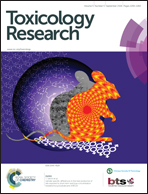Fluoride-induced headkidney macrophage cell apoptosis involves activation of the CaMKIIg-ERK 1/2-caspase-8 axis: the role of superoxide in initiating the apoptotic cascade†
Abstract
Fluoride is known to induce apoptosis though the mechanisms remain obscure. The aim of the present study was to understand the underlying molecular mechanisms of fluoride-induced apoptosis using fish headkidney macrophages (HKMs). Exposure to fluoride triggered HKM cell apoptosis as evidenced by Hoechst 333432 and AnnexinV–propidium iodide staining, the presence of an internucleosomal DNA ladder and the comet assay. Our results suggest the influx of extra-cellular Ca2+ to be an initial event in fluoride-induced HKM cell apoptosis. We observed persistently elevated levels of superoxide anions and our inhibitor studies with EGTA suggested the primal role of the Ca2+ flux in triggering superoxide production in fluoride-exposed HKM cells. Fluoride exposure led to elevated levels of Ca2+/CaM dependent protein kinase II gamma (CaMKIIg) and pre-treatment with the inhibitor KN-93 but not its inactive structural analogue KN-92 reduced the number of apoptotic cells establishing the pro-apoptotic role of CaMKIIg in fluoride-induced HKM cell apoptosis. We report that the sustained superoxide generation is primarily responsible for the increased CaMKIIg levels observed in fluoride-exposed HKM cells. Our inhibitor studies further implicated CaMKIIg in the activation of extracellular signal-regulated kinases 1 and 2 (ERK 1/2) culminating in caspase-8/caspase-3 mediated apoptosis of HKM cells. We conclude that fluoride-induced apoptosis is largely dependent on Ca2+ induced superoxide generation leading to elevation in CaMKIIg which in turn induces the phosphorylation of ERK 1/2 and downstream activation of extrinsic caspase cascade in HKM cells.


 Please wait while we load your content...
Please wait while we load your content...